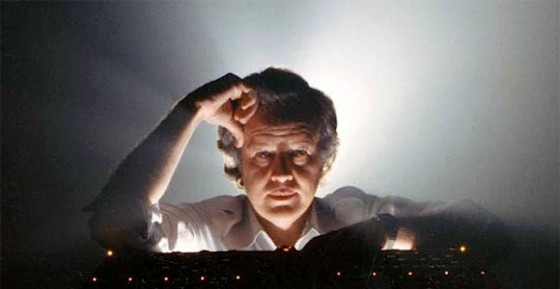
Douglas Trumbull had a strange career trajectory. He was one of the FX wizards who made 2001: A Space Odyssey happen (and later worked on films like Close Encounters and Blade Runner), before transitioning into directing, debuting with the Bruce Dern sci-fi isolation classic Silent Running. Then after directing 1983’s Brainstorm – the production Natalie Wood mysteriously died during – and suffering through the lengthy battle he had with the studio over the film’s completion (they wanted to scrap the film and take the insurance money), he decided he’d had enough of motion picture filmmaking.
He retreated into technology development and a then burgeoning field that he thought might be the future of the movie-watching experience — immersion motion controlled films, like his great but now-defunct Back to the Future ride at Universal Studios Theme Park (replaced by a Simpsons ride). This technology has proven very popular at theme parks and casinos, though obviously never transitioned into actual filmmaking.
Well, it seems Trumbull’s rage with the motion picture industry has cooled a bit over these nearly three decades, because THR is reporting that the man wants to make a film again. And not just any kind of a film. A 3D film. And not just any kind of 3D film. A 3D film shot 60 frames per second (as opposed to the industry standard 24 fps). Trumbull had originally planned to shoot Brainstorm 65mm at 60 fps, but that ended up falling through. But the man has long felt that 24 frames just don’t cut it. “Higher frame rates create a sense of realism. We are now at a time when we can have any film texture we want. But it’s not an either/or situation,” Trumbull said. “James Cameron has been talking publicly about shooting tests in 48 and 60. Peter Jackson wants to do The Hobbit in 60. … It doesn’t seem too daunting [to make this happen].”
No word on what Trumbull’s film will be, but he is apparently currently working on the screenplay. Looking at his filmography, I am going to go out on a limb and say it will probably be science fiction.
Unrelated to Trumbull, the THR article also has a quote from VFX supervisor Rob Legato describing the artistic use of 3D in Scorsese’s Hugo Cabret that I find sort of silly. “[Scorsese is] altering the use of 3D so that instead of a being an obvious, in-your-face visual effect, the viewer is experiencing a sensation of depth. Sometimes that sensation replaces dialogue. You don’t necessarily need to describe a scene in words if you can feel it, and if you can feel it, it’s usually a more powerful moment than anything else.” Ah, finally 3D is allowing us to achieve something that Griffith, Chaplin, Keaton, Lang, Murnau, and a zillion other filmmakers achieved 90 years ago. It’s about time.